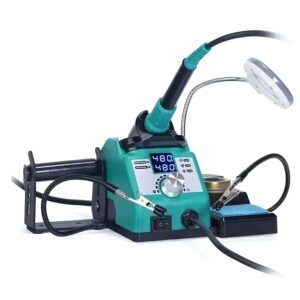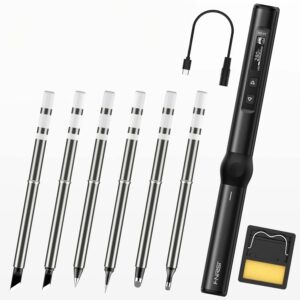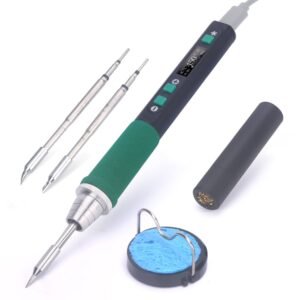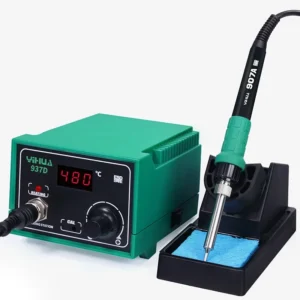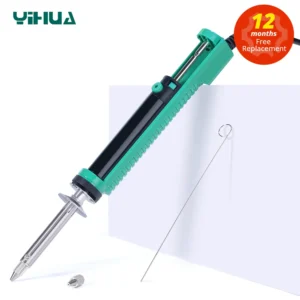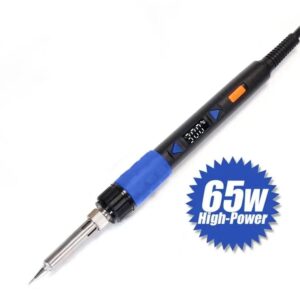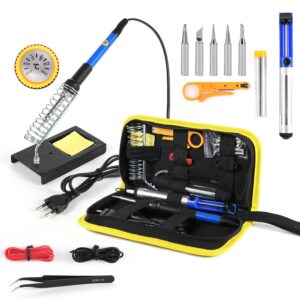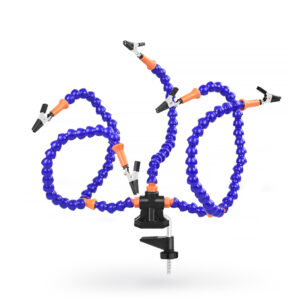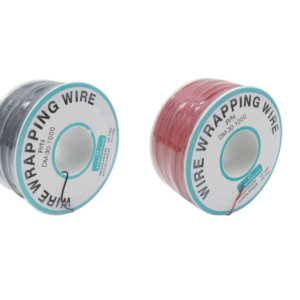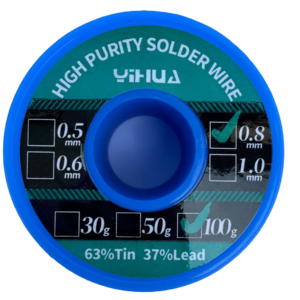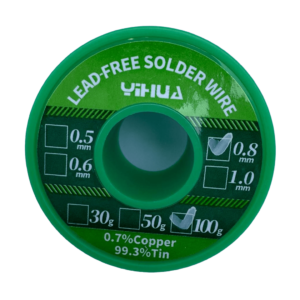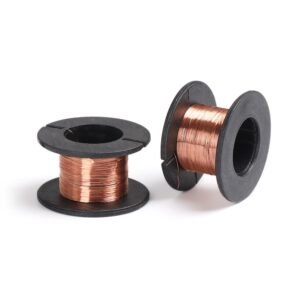Soldering Iron Kits & Accessories
Perfect soldering iron kits for beginners and seasoned enthusiasts, these affordable kits make it easy and fun to dive into electronics work. We also offer a range of Soldering Stations, Soldering Equipment by YIHUA and Hot Air Rework Stations.
All items come with Fast Shipping from UK, 60 day return period and 1 year waranty.
Showing all 17 resultsSorted by price: high to low
- £11.90Select options This product has multiple variants. The options may be chosen on the product page
Showing all 17 resultsSorted by price: high to low
What is a Soldering Iron?
Typically comprises a soldering iron, which is the primary tool used for melting solder around electrical connections. The kit also includes various tips for different types of soldering tasks, a stand to safely hold the hot iron when not in use, and additional accessories might be included like solder wire, desoldering pump, tweezers, and sometimes flux. These components are collectively designed to address a broad range of soldering needs in electronics.
Importance and Use Cases
Soldering iron kits are crucial for anyone involved in electronic assembly or repair. They make it possible to join electronic components with precision and reliability, which is essential for both building new electronic circuits and repairing existing ones. Common use cases include assembling or fixing printed circuit boards (PCBs), wiring in hobbyist projects like robotics, and crafting custom jewelry or art that incorporates electronic components.
Who Should Use Them
Soldering iron kits are ideal for a wide array of users:
- Hobbyists and DIY enthusiasts who enjoy building and tinkering with electronic gadgets.
- Students learning about electronics and electrical engineering.
- Professional technicians who repair electronic appliances and devices.
- Artists and crafters who incorporate electronic elements into their creations.
Whether you’re a beginner looking to start your first project or a seasoned pro needing to upgrade your existing equipment, a soldering iron kit provides the fundamental tools required to solder effectively and safely. By owning one, you empower yourself to bring electronic inventions and repairs to life with ease.
Exploring the Components
A soldering iron kit is an essential collection of tools designed to equip you for a wide range of soldering projects. Whether you’re assembling electronics, repairing gadgets, or undertaking creative DIY tasks, understanding each component can help you make the most of your kit. Here’s a breakdown of what you’ll typically find in a soldering iron kit:
Soldering Iron
The soldering iron is the heart of the kit. It’s a hand-held tool used to heat solder, which then joins metal workpieces together. Soldering irons come in various models and wattages, accommodating everything from delicate electronic circuits to more robust metalwork. The right soldering iron can make a significant difference in the precision and quality of your projects.
Soldering Tips
Interchangeable tips for the soldering iron allow you to customize the tool based on the task at hand. These tips vary in shape and size, such as pointed tips for detailed work on circuit boards or broader tips for larger, more durable joints. Having a variety of tips enhances the flexibility and versatility of your soldering iron, making it suitable for multiple applications.
Soldering Stand
A soldering stand is an often-underestimated component of the kit. It provides a safe place to hold the hot iron when not in use, preventing accidents and damage to work surfaces. Many stands also include a cleaning sponge or brass coil for wiping the tip mid-use, which is essential for maintaining good soldering hygiene and effectiveness.
Solder Wire
Solder wire is the material that melts to form the joints between components. It typically consists of a combination of tin and lead, or can be entirely lead-free for health and environmental reasons. Solder wire may also be flux-cored, which helps improve the flow and bonding of the solder. The choice of solder wire can impact the strength and conductivity of your soldered joints, affecting the overall durability and functionality of the project.
Also check our Raspberry Pi Compatible Accessories & Components.
Benefits of Using Soldering Iron Kits
Soldering iron kits are not just a basic toolset; they are comprehensive solutions that bring several benefits to both hobbyists and professionals involved in electronics.
Benefits for Electronics Work
Soldering iron kits are tailored to meet the needs of electronics work, where precision and reliability are paramount. The right kit can improve the quality of your solder joints, enhance component connectivity, and ensure long-lasting repairs.
Cost-Effectiveness
One of the key advantages of a soldering iron kit is its cost-effectiveness. Purchasing a complete kit often results in significant savings compared to buying each component separately. Kits come with everything needed to get started right away, including a variety of soldering tips and other accessories,
Versatility
A soldering iron kit offers great versatility, making it suitable for a wide range of applications beyond just electronics. With different tips and adjustable temperature settings, you can tailor the tool to work on projects involving jewellery making, model building, and even automotive repairs.
Common Issues Found in Soldering Iron Kits
Soldering iron kits are indispensable tools for electronics enthusiasts, but mastering their use involves tackling common challenges like temperature control and ensuring durability. Here’s a detailed guide on these critical aspects and how to effectively manage them for optimal soldering performance.
Temperature Control
Proper temperature control is essential for achieving quality solder joints and preventing damage to delicate electronic components.
Common Problems:
Cold Solder Joints: Insufficient heat leads to solder that doesn’t flow properly, resulting in weak connections.
Overheating Components: Excessive heat can damage sensitive parts, affecting their functionality or longevity.
Inconsistent Solder Flow: Incorrect temperature settings can cause solder to flow unevenly or not at all, making soldering difficult.
Troubleshooting Tips:
Adjust Temperature Settings: Set your soldering iron to the appropriate temperature for the type of solder being used (leaded vs. lead-free).
Test on Scrap Material: Before starting on your project, test the temperature on scrap material to ensure it’s suitable for the job at hand.
Use Temperature-Controlled Soldering Stations: Invest in soldering irons with adjustable temperature settings to maintain consistent heat levels throughout your work.
Preventive Measures:
Monitor Temperature: Regularly check and adjust the temperature as needed during soldering sessions to prevent overheating or underheating.
Invest in Quality Equipment: Choose soldering irons with reliable temperature control features to ensure accurate and consistent performance over time.
Durability
The durability of a soldering iron kit directly impacts its effectiveness and lifespan. Issues such as tip oxidation and general wear can affect soldering quality and efficiency.
Common Problems:
Tip Oxidation: Build up of oxidation on the soldering iron tip reduces heat transfer efficiency, leading to poor soldering results.
Tip Contamination: Accidental contact with contaminants or residues can degrade soldering performance and create unreliable joints.
General Wear and Tear: Continuous use can wear down tips and other parts of the soldering iron, affecting overall functionality.
Troubleshooting Tips:
Clean the Tip Regularly: Use a damp sponge or brass wire cleaner to remove oxidation and residue from the tip before and after each use.
Inspect and Replace Tips: Periodically check the condition of the soldering iron tip and replace it when signs of wear or damage appear to maintain optimal performance.
Store Properly: Store your soldering iron in a clean, dry environment to prevent oxidation and extend its lifespan.
Preventive Measures:
- Choose High-Quality Tools: Invest in soldering iron kits with durable components and replaceable tips to ensure longevity and reliable performance.
- Follow Manufacturer’s Guidelines: Adhere to recommended maintenance practices provided by the manufacturer to prolong the life of your soldering equipment.
How to Choose the Right Soldering Iron Kit
Choosing the right soldering iron kit requires careful consideration of several factors tailored to your specific needs and applications. Here’s a comprehensive guide to help you make an informed decision.
Consider the types of projects you intend to undertake. For electronics repair, opt for kits with fine tips and moderate temperature ranges suitable for delicate components. If you’re assembling circuit boards, choose kits with adjustable temperatures and various tip sizes to accommodate different soldering requirements.
The frequency of use also plays a role in your decision-making process. If you solder occasionally, basic kits with essential tools will suffice. However, for frequent use, investing in higher-quality kits with durable components and ergonomic designs will provide comfort and reliability during prolonged soldering sessions.
Portability is another factor to consider based on your workspace setup. Larger kits with more accessories are suitable for fixed workspaces where comprehensive soldering tasks are performed. Conversely, if you need to solder in different locations or have limited space, opt for compact kits that are easy to carry without compromising on essential features.
Budget considerations will influence your choice as well. Entry-level kits are affordable and suitable for beginners or those on a budget. Mid-range kits strike a balance between quality and features, making them ideal for hobbyists and moderate users. High-end kits with advanced features such as digital displays, programmable presets, and precise temperature control are recommended for professionals.
Types of Soldering Kits
Understanding the different types of soldering iron kits available is essential:
- Basic Kits.
- Adjustable Temperature Kits.
- Digital Soldering Stations
Frequently Asked Questions (FAQs) about Soldering Iron Kits
What is included in a typical soldering iron kit?
A soldering iron kit typically includes a soldering iron (with various wattages), interchangeable tips, a stand, solder wire, and accessories like tweezers and a desoldering pump.
Why are soldering iron kits important for electronics work?
They facilitate precise joining of electronic components, essential for assembling or repairing circuit boards and integrating electronics into DIY projects.
Who should use soldering iron kits?
Ideal for hobbyists, students, professionals, and artists needing to solder electronic components for various projects.
What are the benefits of using soldering iron kits?
Cost-effectiveness, versatility for diverse applications beyond electronics, and enhanced precision in soldering tasks.
What are common issues with soldering iron kits?
Temperature control problems (cold joints, overheating) and durability issues (tip oxidation, wear) affecting soldering quality.
Common Concerns and Queries
Addressing common concerns and queries about soldering iron kits helps users navigate their usage effectively.
Frequently encountered issues
Challenges with temperature control can lead to poor soldering results when the iron lacks adjustable settings or isn’t calibrated properly. Durability concerns focus on the longevity of soldering iron tips, which can oxidize over time, affecting heat transfer and joint quality.
Customer concerns
Safety considerations include handling hot irons and soldering fumes, emphasizing the need for proper ventilation and protective gear. Compatibility concerns arise regarding solder wire types and their suitability for specific projects, impacting solder flow and joint reliability.
Expert advice
Optimal temperature management is crucial for consistent soldering results; adjustable irons and testing on scrap material can help achieve this. Regular maintenance, like cleaning tips and storing equipment properly, extends the lifespan and effectiveness of soldering tools. Skill development through practice and adherence to manufacturer guidelines ensures safe and efficient use of soldering iron kits, maximizing their utility.
Where to buy soldering iron in UK?
At Kunkune. We stock reliable soldering irons for beginners and pros—plus tips, solder, mats, and accessories—at competitive prices with fast UK delivery.
All they come with 60 day return period and 1 year waranty.


